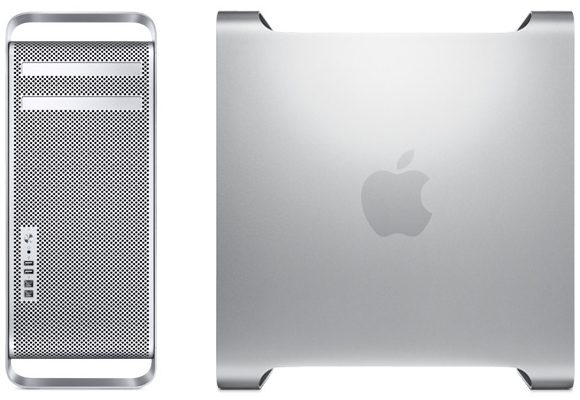

When we post Final Cut Pro X 10.1 results, the FirePros in the new Mac Pro will have an opportunity to shine. That's why the single AMD GPUs in the Mac Pro tower match or exceed the dual D300 and dual D500 framerates. OpenGL Benchmarks are not multi-GPU aware - at least not at this time. Dual FirePro D700s should match the KSamples/sec achieved by the dual Radeon HD 7970s we tested. We haven't tested the FirePro D700s yet, but you can see, the D300s and D500s beat the fastest solo AMD GPUs we installed in the 2010 Mac Pro. We featured LuxMark is an OpenCL benchmark since it uses multiple GPUs. It's encouraging to know there are equally fast flash storage options for those of you keeping your Mac Pro towers for now. Since the newest Mac Pro has PCIe flash STORAGE, we installed PCIe based flash storage cards in the 2010 Mac Pro. When it comes to CPU crunching, the 'late 2013' Mac Pro 6-core is faster than the 'mid 2010' Mac Pro 6-core in both single and multi-core tests. GPUtest - TessMark 圆4/圆4, OpenGL 4.0 tessellation test run at 640x480 Windowed. GPUtest - Volplosion - OpenGL (2.1 or 3.2) pixel shader test run at 640x480 Windowed.

(LONGER bar means FASTER.)Ģ010 MP 6c G780 = 'mid 2010' Mac Pro 6-core with single GeForce GTX 780 GPUĢ010 MP 6c G680 = 'mid 2010' Mac Pro 6-core with single GeForce GTX 680 GPU We used Extreme preset: 1600x900 windowed resolution with 8x Anti-aliasing, Ultra Quality for Shaders and Textures, and with Occlusion, Refraction, and Volumetric Shadows enabled. It features advanced visual technologies: dynamic sky, volumetric clouds, sun shafts, DOF, ambient occlusion. Valley Benchmark "flies" through forest-covered valley surrounded by vast mountains, presenting a bird’s eye view of 64 million meters of extremely detailed terrain down to every leaf and flower petal. (LARGER number means FASTER in Thousands of Samples per Second.)Ģ010 MP 6c 7970*2 = 'mid 2010' Mac Pro 6-Core with dual Radeon HD 7970 GPUsĢ013 MP 6c D500*2 = 'late 2013' Mac Pro 6-core with dual FirePro D500 GPUsĢ013 MP 4c D300*2 = 'late 2013' Mac Pro 4-core with dual FirePro D300 GPUsĢ010 MP 6c 7970 = 'mid 2010' Mac Pro 6-core with single Radeon HD 7970 GPUĢ010 MP 6c 7950 = 'mid 2010' Mac Pro 6-core with single Radeon HD 7950 GPU For this round we used the default Sala scene (488K Triangles) and rendered using GPUs only. LuxMark 2.1 is an OpenCL benchmark that renders scenes of various complexity. We use the Standard Random test in QuickBench as a predictor boot volume performance and a simulation of an application that does multiple small random transfers. We used AJA System Test to test file level, large sequential transfer speed using a 16GB test document that simulates a video whose frame size is 4096x2160.

Geekbench 3 - Here is the overall score for 64-bit performance of Integer, Floating Point, and Memory (HIGHER score means FASTER.)Ģ013 MP 6c Factory = 'late 2013' Mac Pro Xeon 6-Core with Factory 256G PCIe flash storageĢ010 MP 6c Accel*2 = 'mid 2010' Mac Pro Xeon 6-core with two Mercury Accelsior_E2 PCIe SSD cards striped (RAID 0) using Disk UtilityĢ010 MP 6c Tempo = 'mid 2010' Mac Pro Xeon 6-core with Sonnet Tempo SSD Pro PCIe card. We decided to see how it compared to the 'mid 2010' Mac Pro 3.33GHz Hex-Core.Ģ013 MP 6c 3.5GHz = 'late 2013' Mac Pro Xeon E5-1650v2 3.5GHz 6-Core with 16G of 1866MHz DDR3, Dual FirePro D500s, and 256G PCIe flash storageĢ010 MP 6c 3.33GHz = 'mid 2010' Mac Pro Xeon W3680 3.33GHz 6-core with 24G of 1333MHz DDR3, Radeon HD 7950, and Sonnet Tempo Pro SSDĬinebench R15 - Render 3D Model using all cores. Thanks to the Other World Computing's test lab, we have some preliminary benchmarks on the entry level 'late 2013' Mac Pro 3.5GHz Hex-Core.


 0 kommentar(er)
0 kommentar(er)
